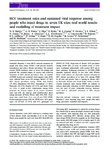<scp>HCV</scp> treatment rates and sustained viral response among people who inject drugs in seven <scp>UK</scp> sites: real world results and modelling of treatment impact
| dc.contributor.author | Martin, NK | |
| dc.contributor.author | Foster, GR | |
| dc.contributor.author | Vilar, J | |
| dc.contributor.author | Ryder, S | |
| dc.contributor.author | E. Cramp, M | |
| dc.contributor.author | Gordon, F | |
| dc.contributor.author | Dillon, JF | |
| dc.contributor.author | Craine, N | |
| dc.contributor.author | Busse, H | |
| dc.contributor.author | Clements, A | |
| dc.contributor.author | Hutchinson, SJ | |
| dc.contributor.author | Ustianowski, A | |
| dc.contributor.author | Ramsay, M | |
| dc.contributor.author | Goldberg, DJ | |
| dc.contributor.author | Irving, W | |
| dc.contributor.author | Hope, V | |
| dc.contributor.author | De Angelis, D | |
| dc.contributor.author | Lyons, M | |
| dc.contributor.author | Vickerman, P | |
| dc.contributor.author | Hickman, M | |
| dc.date.accessioned | 2016-12-15T15:19:41Z | |
| dc.date.available | 2016-12-15T15:19:41Z | |
| dc.date.issued | 2015-04 | |
| dc.identifier.issn | 1352-0504 | |
| dc.identifier.issn | 1365-2893 | |
| dc.identifier.uri | http://hdl.handle.net/10026.1/8128 | |
| dc.description.abstract |
<jats:title>Summary</jats:title><jats:p>Hepatitis C virus (<jats:styled-content style="fixed-case">HCV</jats:styled-content>) antiviral treatment for people who inject drugs (<jats:styled-content style="fixed-case">PWID</jats:styled-content>) could prevent onwards transmission and reduce chronic prevalence. We assessed current <jats:styled-content style="fixed-case">PWID</jats:styled-content> treatment rates in seven <jats:styled-content style="fixed-case">UK</jats:styled-content> settings and projected the potential impact of current and scaled‐up treatment on <jats:styled-content style="fixed-case">HCV</jats:styled-content> chronic prevalence. Data on number of <jats:styled-content style="fixed-case">PWID</jats:styled-content> treated and sustained viral response rates (<jats:styled-content style="fixed-case">SVR</jats:styled-content>) were collected from seven <jats:styled-content style="fixed-case">UK</jats:styled-content> settings: Bristol (37–48% <jats:styled-content style="fixed-case">HCV</jats:styled-content> chronic prevalence among <jats:styled-content style="fixed-case">PWID</jats:styled-content>), East London (37–48%), Manchester (48–56%), Nottingham (37–44%), Plymouth (30–37%), Dundee (20–27%) and North Wales (27–33%). A model of <jats:styled-content style="fixed-case">HCV</jats:styled-content> transmission among <jats:styled-content style="fixed-case">PWID</jats:styled-content> projected the 10‐year impact of (i) current treatment rates and <jats:styled-content style="fixed-case">SVR</jats:styled-content> (ii) scale‐up with interferon‐free direct acting antivirals (<jats:styled-content style="fixed-case">IFN</jats:styled-content>‐free <jats:styled-content style="fixed-case">DAA</jats:styled-content>s) with 90% <jats:styled-content style="fixed-case">SVR</jats:styled-content>. Treatment rates varied from <5 to over 25 per 1000 <jats:styled-content style="fixed-case">PWID</jats:styled-content>. Pooled intention‐to‐treat <jats:styled-content style="fixed-case">SVR</jats:styled-content> for <jats:styled-content style="fixed-case">PWID</jats:styled-content> were 45% genotypes 1/4 [95%<jats:styled-content style="fixed-case">CI</jats:styled-content> 33–57%] and 61% genotypes 2/3 [95%<jats:styled-content style="fixed-case">CI</jats:styled-content> 47–76%]. Projections of chronic <jats:styled-content style="fixed-case">HCV</jats:styled-content> prevalence among <jats:styled-content style="fixed-case">PWID</jats:styled-content> after 10 years of current levels of treatment overlapped substantially with current <jats:styled-content style="fixed-case">HCV</jats:styled-content> prevalence estimates. Scaling‐up treatment to 26/1000 <jats:styled-content style="fixed-case">PWID</jats:styled-content> annually (achieved already in two sites) with <jats:styled-content style="fixed-case">IFN</jats:styled-content>‐free <jats:styled-content style="fixed-case">DAA</jats:styled-content>s could achieve an observable absolute reduction in <jats:styled-content style="fixed-case">HCV</jats:styled-content> chronic prevalence of at least 15% among <jats:styled-content style="fixed-case">PWID</jats:styled-content> in all sites and greater than a halving in chronic <jats:styled-content style="fixed-case">HCV</jats:styled-content> in Plymouth, Dundee and North Wales within a decade. Current treatment rates among <jats:styled-content style="fixed-case">PWID</jats:styled-content> are unlikely to achieve observable reductions in <jats:styled-content style="fixed-case">HCV</jats:styled-content> chronic prevalence over the next 10 years. Achievable scale‐up, however, could lead to substantial reductions in <jats:styled-content style="fixed-case">HCV</jats:styled-content> chronic prevalence.</jats:p> | |
| dc.format.extent | 399-408 | |
| dc.format.medium | Print-Electronic | |
| dc.language | en | |
| dc.language.iso | eng | |
| dc.publisher | Wiley | |
| dc.subject | antiviral treatment | |
| dc.subject | direct acting antivirals | |
| dc.subject | hepatitis C virus | |
| dc.subject | injecting drug users | |
| dc.subject | people who inject drugs | |
| dc.subject | prevention | |
| dc.subject | sustained viral response | |
| dc.title | <scp>HCV</scp> treatment rates and sustained viral response among people who inject drugs in seven <scp>UK</scp> sites: real world results and modelling of treatment impact | |
| dc.type | journal-article | |
| dc.type | Journal Article | |
| dc.type | Research Support, Non-U.S. Gov't | |
| plymouth.author-url | https://www.webofscience.com/api/gateway?GWVersion=2&SrcApp=PARTNER_APP&SrcAuth=LinksAMR&KeyUT=WOS:000352144300007&DestLinkType=FullRecord&DestApp=ALL_WOS&UsrCustomerID=11bb513d99f797142bcfeffcc58ea008 | |
| plymouth.issue | 4 | |
| plymouth.volume | 22 | |
| plymouth.publication-status | Published | |
| plymouth.journal | Journal of Viral Hepatitis | |
| dc.identifier.doi | 10.1111/jvh.12338 | |
| plymouth.organisational-group | /Plymouth | |
| plymouth.organisational-group | /Plymouth/Faculty of Health | |
| plymouth.organisational-group | /Plymouth/Faculty of Health/Peninsula Medical School | |
| plymouth.organisational-group | /Plymouth/REF 2021 Researchers by UoA | |
| plymouth.organisational-group | /Plymouth/REF 2021 Researchers by UoA/UoA01 Clinical Medicine | |
| plymouth.organisational-group | /Plymouth/Research Groups | |
| plymouth.organisational-group | /Plymouth/Research Groups/Institute of Translational and Stratified Medicine (ITSMED) | |
| plymouth.organisational-group | /Plymouth/Research Groups/Institute of Translational and Stratified Medicine (ITSMED)/CBR | |
| plymouth.organisational-group | /Plymouth/Users by role | |
| plymouth.organisational-group | /Plymouth/Users by role/Academics | |
| dc.publisher.place | England | |
| dc.identifier.eissn | 1365-2893 | |
| dc.rights.embargoperiod | No embargo | |
| rioxxterms.funder | Medical Research Council | |
| rioxxterms.identifier.project | DECIPHer: Centre for the Development and Evaluation of Complex Interventions for Public Health Improvement | |
| rioxxterms.versionofrecord | 10.1111/jvh.12338 | |
| rioxxterms.licenseref.uri | http://www.rioxx.net/licenses/all-rights-reserved | |
| rioxxterms.type | Journal Article/Review | |
| plymouth.funder | DECIPHer: Centre for the Development and Evaluation of Complex Interventions for Public Health Improvement::Medical Research Council |


